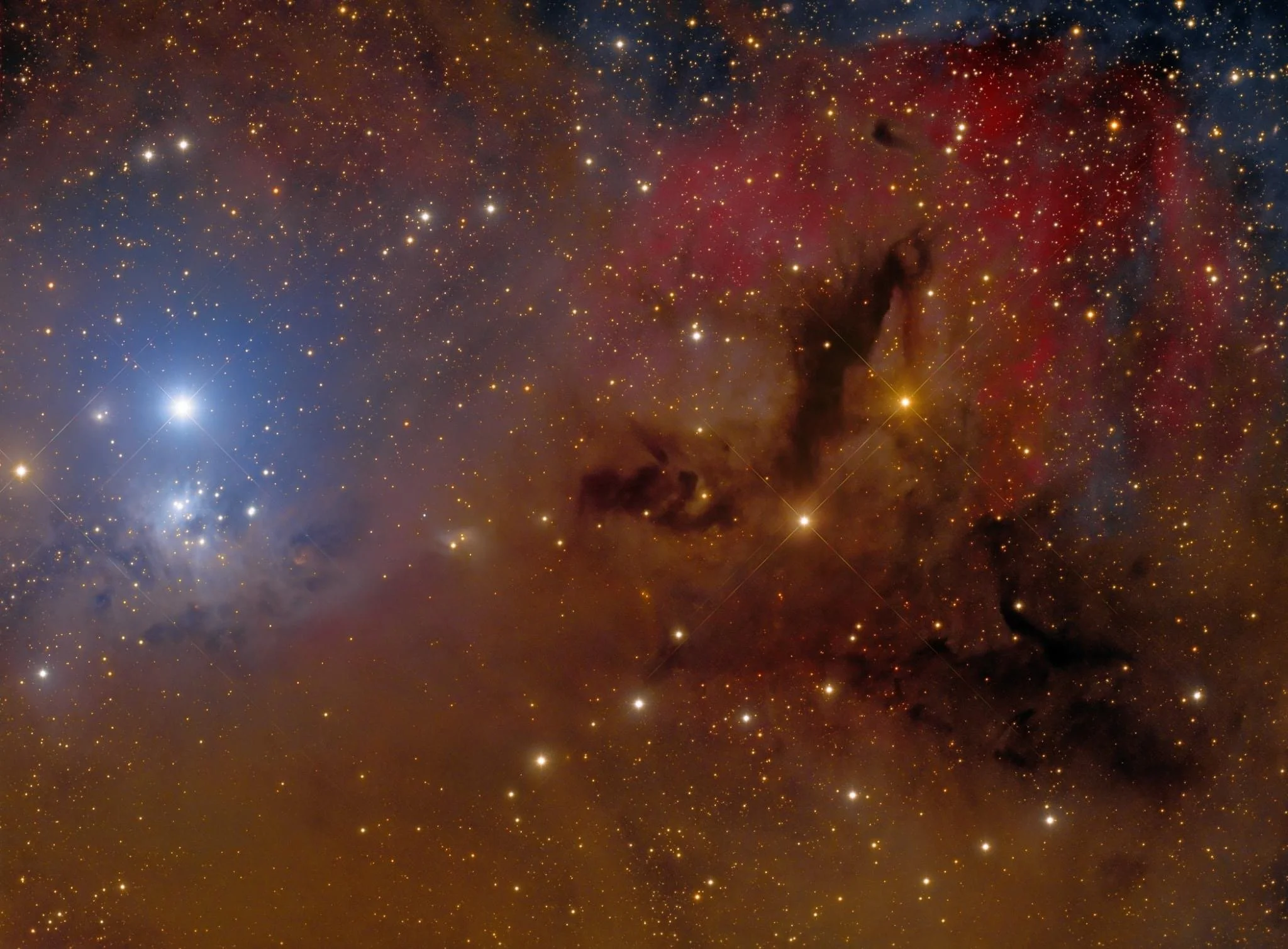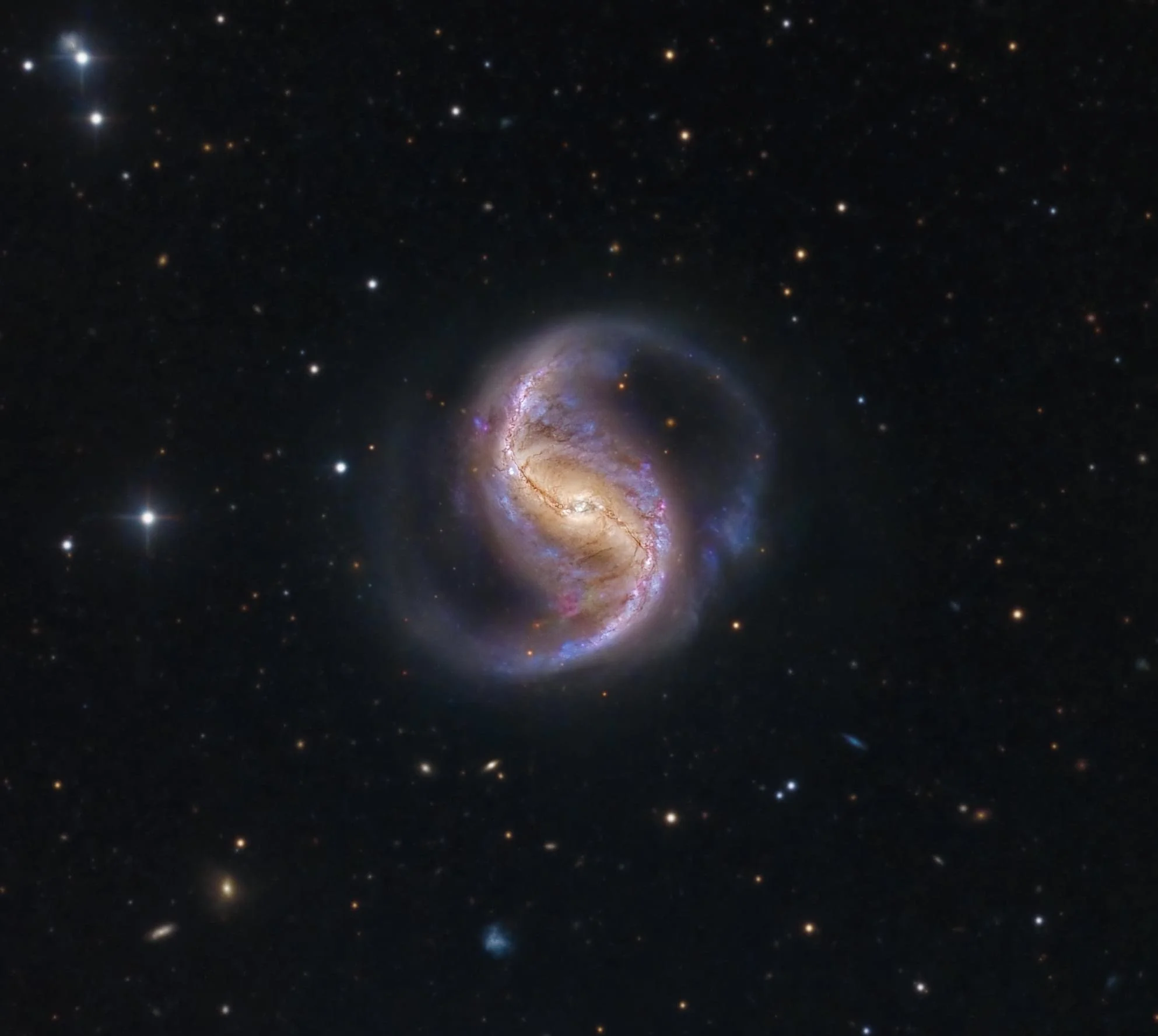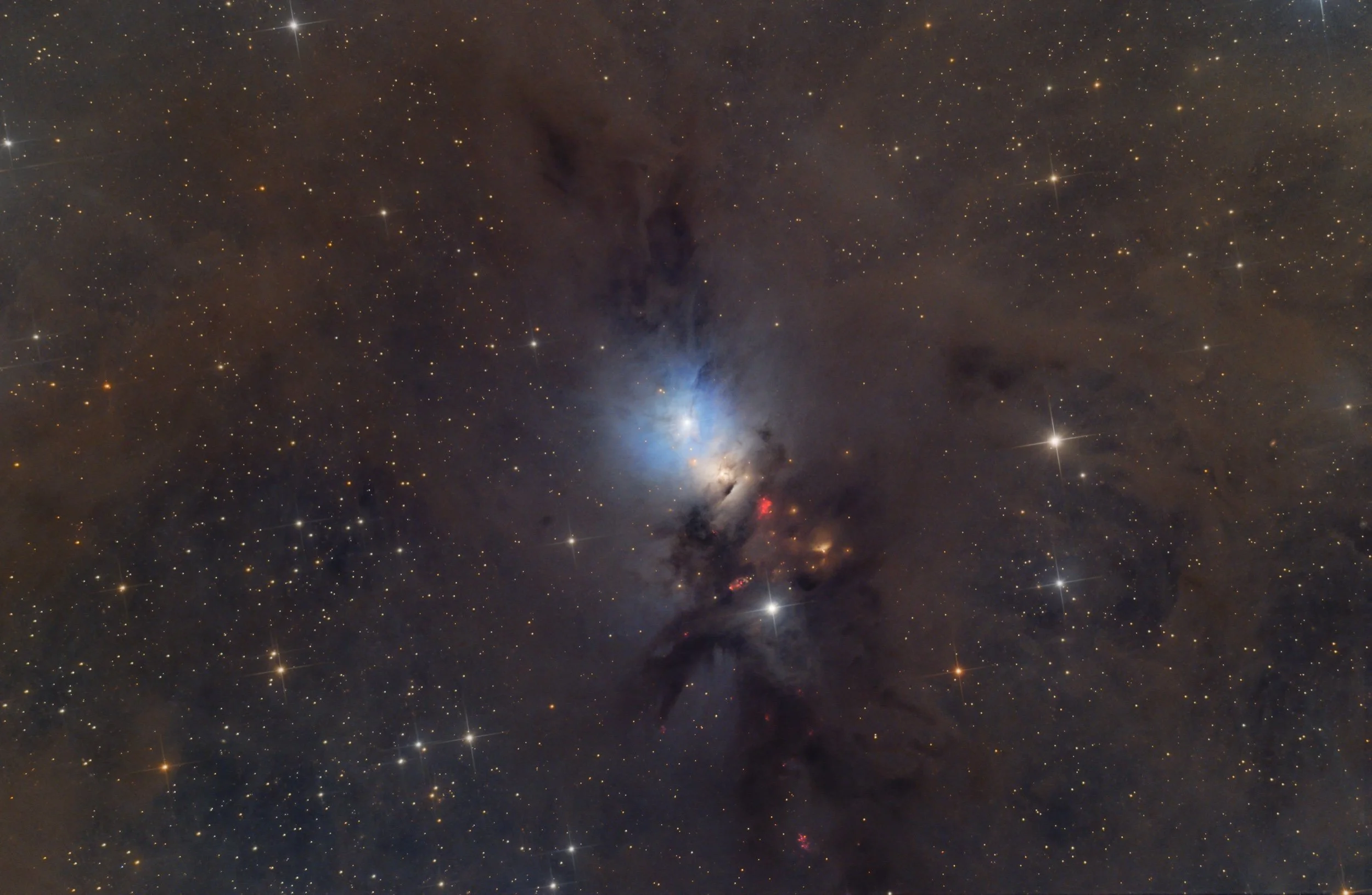
AAPOD2 Image Archives
SH2-261 / Lower's Nebula
Image Description and Details :
Lower's nebula (Sh2-261) is found on the outermost edge of our Milkyway between the Orion and Perseus arm. Sh2-261 is a large faint region of predominantly ionized hydrogen. The nebula is named after Harold and Charles Lower who discovered this nebula in 1939.
Embedded within Sh2-261 is LBN 862 and LBN 864. Also there are several dark nebulae in this field.
Imaging telescopes or lenses: Takahashi FSQ130ED
Imaging cameras: QSI 6120i
Mounts: Takahashi EM 400 Temma 2M
Guiding telescopes or lenses: Takahashi FS60CB
Guiding cameras: QHY CCD QHY 5 II
Focal Extender / Reducer: Tak QE 0.73x
Software: PHD 2, Pleiades Astrophoto PixInsight , Astro Pixel Processor (for stacking), Sequence Generator Pro SGP (for capture)
Filters: Astrodon Ha, SII, OIII,
Accessories: Robofocus Focuser, ATIK EFW3
Original Resolution: 3600x 2400
Dates: 3rd Nov - 8th Nov '21
Frames:
Astrodon Ha 18 x 20'
Astrodon SII 24 x 20'
Astrodon OIII 30 x 20'
Total Time: 24 Hours
Center (RA, Dec): (92.351, 15.689)
Center (RA, hms): 06h 09m 24.153s
Center (Dec, dms): +15° 41' 18.668"
Size: 80.7 x 53.8 arcmin
Radius: 0.808 deg
Pixel scale: 1.34 arcsec/pixel
Orientation: Up is 180 degrees E of N
Copyright: Brendan Kinch
Supernova Remmant W63 (G082.2+05.3)
Image Description and Details :
EQUIPMENT DATA:
Telescope: Borg 101ED f/4
Mount: Skywatcher HEQ5 (Rowan Belt Mod)
Camera: QHYCCD 163M
Filters: Optolong H OIII
Guide Scope: DIY Guidescope 43mm f/3
Guide Camera: QHY 178M
ADQUISITION DATA:
Location: Castillo de Villamalefa
Date: Summer 2021
Resolution: 1.87″/pixel
Guiding Performance: 1” RMS (average)
Exposures: (Gain 174 / Offset 77 / Bin 1×1)
H: 11.25h (137x300s)
O: 26.35h (319x300s)
Sensor Temperature: -10C
20 Flats
20 Darks
Total Integration Time: 38.5h
Copyright: Alberto Ibañez
The Tulip
Image Description and Details : This colourful region, located in the constellation Cygnus, has many distinct views of energized gas, all of which give a deep sense of wonder and amazement. The night sky is wonderful, always look up!
We are star dust.
——————
This was captured over 8 nights across June and July, only 3 hours at a time due to our limited darkness on the 51st parallel North.
27hr 47min total exposure time
94x300” Sii
84x300” Ha
119x300” Oiii
31x120” R
32x120” G
28xx120” B
40x Darks
180 Flats/Dark Flats
06/06, 06/25-30, 07/09/2021
Bortle 6/7
Calgary, AB
Setup#1 - SHO
711mm Focal Length
@williamoptics GT102
@williamoptics Flat68iii
@antliafilters SHO 3nm, 2”
@antliafilters RGB, 2”
@skywatcherusa EQ6-R Pro
@zwoasi ASI2600MM-Pro, unity, -10C
@zwoasi EAF
@zwoasi EFW 7x2, 2”
@zwoasi OAG68M
@zwoasi ASI290MM-mini
@zwoasi ASIAir Pro
APP, PI, PS, MLR
Copyright: Andrew Lesser
IC348 and surroundings
Image Description:
Takahashi FSQ106EDXIII
QSI683
Paramount ME
Astrodon Tru-Balance E-Series Gen 2 L: 23 · 900s
Astrodon Tru-Balance E-Series Gen 2 RGB: (26, 26, 24) · 900s
Copyright: R. Colombari
VdB 9
Image Description and Details :
This is the 9th object in the van der Bergh surrounded by LDN 1357 and 1355 in the constellation Cassiopeia.
Captured over 2 nights with a Celestion EdgeHD 9.25" at 2350mm focal length for a total of 18.625 hours using LRGB filters.
Copyright: Matthew Proulx
Ghost Crater (Astroavani/Brazil-2012)
Image Description and Details : With only 2 months left to complete 10 years of the ghost crater discovered by me, I present a new photo in better resulution of the formation in question and take the opportunity to transcribe the original text with some minor adaptations."I've always had the greatest interest in astrophotography of Lunar formations and from the beginning, using mainly the Virtual Moon Atlas, I tried to find and know the most striking features of the regions I observed or photographed.As time went by, I acquired a better knowledge and more easily recognized these regions and their main accidents, which greatly facilitated the perception of anything that clashed with the traditionally observed landscape.So on January 5, 2012, photographing the region near Plateau Aristarchus, I noticed a strange depression that caught my attention. I tried to locate it on lunar maps and even in the Virtual Moon Atlas, but I found nothing.I searched the internet, asked for help from colleagues in Brazil and abroad to clarify what this training could be, I believed that it should already be known or that others had already observed it.In principle, I couldn't find any reference to this lunar formation.Looking at the attached photo, the impression we have is the existence of a depression that is only revealed when the Sun is at a very low angle of illumination.I sent the original photos to my friend Vaz Tolentino from the Lunar Observatory (VTOL) back in 2012 and he gave me the following explanation: Indeed, your photo, due to the angle of sunlight, captured an interesting and unusual circular depression, which has along its southwestern rim, the crater WOLLASTON D (5km in diameter). The formation is very strange in that it doesn't look in the style of known ghost craters. The strange and unusual thing is that, it appears that the supposed crater was flooded by basaltic lava and, instead of filling up and leveling off with the surrounding outer floor, it only filled a little and didn't even out, remaining like a "gourd" or "bowl ", in addition to leaving no traces of a central peak. This depression appears to be about 42 km in diameter, being slightly larger than ARISTARCHUS. I checked LRO images and unfortunately I can't identify anything due to the sunlight being high in the photos. We need more photos of this region, in light conditions similar to the one in this photo.At Alexandre Amorim's suggestion, I decided to contact BAA (http://www.baalunarsection.org.uk/) Lunar Section where I made contact with Dr. Anthony Cook. I sent to the same the photos obtained by me in January and June 2012, as well as I reported the suspicion that the referred depression had not yet been catalogued. After exchanging several emails, I received the following message from Dr. Cook, which I transfer in full:On Mon 4/06/12 07:06 , "Tony Cook [atc]" atc@aber.ac.uk sat:Dear Avani,Thank you for your images. It looks like a buried ghost crater that you have found. Please keep on looking for another ghost craters elsewhere on the Moon because I think that there may be quite a few that are visible near to sun rise or sunset that remain to be discovered. I think this work will be of great interest to Peter the Greek.
Dr Anthony Cook Institute of Mathematics and Physics, Aberystwyth University, Penglais, Aberystwyth, Ceredigion. SY23 3BZ. United KingdomIn April 2013 using the new QHY 5L camera, a color CMOs dedicated to high resolution Lunar and planetary photography, I got a more detailed photo of the place where the depression was located:This allowed colleague Vaz Tolentino to trace the altimetric profile of depression and perform the following analysis:"Dear Avani and Amorim:Analyzing the Avani photos (January/2012 - April/2013), together with the altimetric profile that presents a classic phantom crater depression, I reach the conclusion that, most likely, it is the discovery of a new phantom crater without cataloging.Also analyzing the altimetry of the ghost craters DAGUERRE, LAMONT and that discovered by VTOL in February 2011, I came to the conclusion that they have very similar altimetric profiles, and the Avani ghost crater is a little shallower (46 km of diameter per 130 m depth) than DAGUERRE and LAMONT (both approximately 400 m deep).However, Avani's ghost crater depth (130m) is more compatible with the ghost crater discovered by VTOL (which is approximately 100m deep). What this means?It means that, in the past (at the time of the ancient selenographers), when the main interest in observing the Moon was to map its relief, identifying and naming its formations, they did not have the current technology, that is, shallow formations like these two Phantom craters (Avani and VTOL) are very difficult to see through an eyepiece, to be sure of what you are actually looking at.After the initial period of cataloging and naming relief formations, lunar map drawings and other studies, the space age arrived. The first robotic lunar probes (Soviet and American) and the manned landings of the APOLLO missions had other scientific goals than discovering new, uncatalogued formations. Furthermore, even in the very high resolution photos taken by modern robotic lunar probes (SELENE, LRO, GRAIL, etc.), the images were mostly captured with sunlight coming from above and not obliquely, which makes it difficult relief enhancement and does not facilitate the identification of shallower formations such as these phantom craters.For modern selenographs, only after the technological evolution of digital cameras (CCD and CMOS), together with the evolution of telescope optics (large and good mirrors and also APO lenses), combined with the favorable angle of incidence of light on the lunar surface, it became easier to identify new smaller formations, "camouflaged" and not cataloged on the Moon.Congratulations Avani Soares on your discovery!Another point marked by the new generation of Brazilian selenographers. A hug from the VTOL team!In this way, I believe that any misunderstanding regarding the existence and identification of the aforementioned training is ruled out, only lacking the official disclosure and recognition to crown the aforementioned work."
Copyright: Astroavani
ngc 986
NGC 986 is a barred spiral galaxy in the constellation of Fornax, located about 56 million light-years away. It is a small target and is not imaged often. The galaxy contains two large, extended and slightly warped arms that begin at each end of the central bar.
Young blue stars are spread through the arms and the core of the galaxy glows with star formation surrounded by numerous dust lanes.
Imaged in LRGB at El Sauce, Obstech, Chile on our CDK 1000
Image Processing: Mike Selby
soul nebula
Imaging telescopes or lenses: Telescop Service TS-PHOTON 10" F4 Advanced Newtonian Telescope with Carbon Tube
Imaging cameras: ZWO ASI294MM Pro
Mounts: iOptron CEM70 CEM70-NUC
Guiding telescopes or lenses: Williams Optics RedCat 51
Guiding cameras: ZWO ASI290MM Mini
Focal reducers: Telescope Service TS-Optics NEWTON Coma Corrector 1.0x TSGPU Superflat - 4-element
Software: PixInsight · Lightroom · Photoshop
Filters: Astronomik S2 1.25" 6nm · Astronomik 1.25" Ha 6nm · Astronomik 1.25" OIII 6nm
Accessory: MoonLite CRL 2.5" Focuser/Stepper Motor/V2 mini Controller · ZWO EFW 1.25" 8 positions
Frames:
Astronomik 1.25" Ha 6nm: 61x180" (3h 3') -20C bin 2x2
Astronomik 1.25" OIII 6nm: 67x180" (3h 21')-20C bin 2x2
Astronomik S2 1.25" 6nm: 70x180" (3h 30') -20C bin 2x2
Integration: 9h 54'
Copyright: Andrei Gusan
The Grus Triplet
Image Description and Details : The Grus Triplet is group of galaxies about 60 million light years away in the constellation Grus and is comprised of NGC 7582, NGC 7590, and NGC 7599. These three galaxies along with NGC 7552 make up the Grus Quartet, which is part of the IC 1459 Group.
Location/Date – El Sauce, Chile, August 2021
Imaging System – Planewave 17” CDK, 10 Micron GM3000, FLI ML16803 Chroma Filters
Exposure – LRGB, 11 hours
Copyright: Good Astronomy
NGC 1333 in Perseus molecular cloud
Image Description and Details : NGC 1333 is a reflexion nebula, located inside the Perseus molecular cloud
This picture combines 24h20' of data, taken during four nights. Long exposure reveals faint structures surrounding the nebula.
Scope : 200/1000 Newtonian
Mount : eq6r-pro
Camera : ASI2600 MC
Off axis guiding
No filter
146x600s : 24h20'
Copyright: Yann MEVEL











